For example, I've passive BPF series RLC circuit with the information of lower and upper cut-off frequencies. I need to find out the values of R, L and C. Is it possible?
Thanks in advance.
For example, I've passive BPF series RLC circuit with the information of lower and upper cut-off frequencies. I need to find out the values of R, L and C. Is it possible?
Thanks in advance.
I've passive BPF series RLC circuit with the information of lower and upper cut-off frequencies.
That will tell you the resonant frequency and the Q-factor.
I need to find out the values of R, L and C. Is it possible?
Unfortunately not. Q-factor depends on all three values with L and C being in a ratio whereas the resonant frequency is a function the product of L and C so, no substitutions are possible to pin-point one component value.
However, if you make an estimated guess of (say) inductance, you can find R and C using the Q-factor and the resonant frequency.
A simple bandpass filter is easy to figure out values going from a low-pass (LPF) prototype to bandpass (BPF) filter.
Low-pass prototype for a series LCR BPF
The bandwidth of the BPF is the corner frequency, \$ f_c
\$, of the LPF prototype.
$$ f_c = {R \over 2 \pi L} $$
It is up to you to choose reasonable component values.
LPF prototype to BPF transformation
To create a bandpass filter, add a capacitor in series with the inductor to resonate the filter at the desired center frequency. The center frequency, \$f_o\$, is the geometric mean of the upper (\$f_H\$) and lower (\$f_L\$) cutoff frequencies.
$$ f_o = \sqrt{f_H \cdot f_L} $$
The center frequency of an LC filter is $$ f_o = {1 \over 2 \pi \sqrt{LC}} $$
I'll let you do the algebra to figure out the capacitance.
Example:
The LPF prototype gives a cutoff frequency of 79.6 kHz which is close to the cursor readout of 80.24 kHz (cursor needs to be on -3.01 dB to give correct value). The BPF, the cursor shows the bandwidth as 79.37 kHz which is close to the calculated value and a cursor resonant frequency of 15.92 kHz which is close to the calculated resonant frequency of 15.92 kHz.
There is another form of an RLC BPF with a series resistor from the source to a parallel LC combination connected to ground. In this case, the LPF prototype is formed by the RC combination. This form is easier to implement with a negative impedance converter (NIC) since the inductor is grounded on one end.
An excellent book on LC filters is "Simplified Modern Filter Design", by Philip Geffe. It goes in to detail about LPF prototype to BPF and other filter transformations.
Well, let's analyze the following circuit:

simulate this circuit – Schematic created using CircuitLab
The transfer function is given by:
\begin{equation} \begin{split} \mathscr{H}\left(\text{s}\right)&=\frac{\text{V}_\text{o}\left(\text{s}\right)}{\text{V}_\text{i}\left(\text{s}\right)}\\ \\ &=\frac{\displaystyle\text{R}}{\displaystyle\text{R}+\text{sL}+\frac{1}{\text{sC}}}\\ \\ &=\frac{\displaystyle\text{R}\text{sC}}{\displaystyle\text{R}\text{sC}+\text{sL}\text{sC}+\frac{\text{sC}}{\text{sC}}}\\ \\ &=\frac{\displaystyle\text{CRs}}{\displaystyle1+\text{CRs}+\text{CLs}^2} \end{split}\tag1 \end{equation}
When working with sinusoidal inputs we know that we can write \$\text{s}:=\text{j}\omega\$ where \$\text{j}^2=-1\$. So we get:
\begin{equation} \begin{split} \left|\space\underline{\mathscr{H}}\left(\text{j}\omega\right)\right|&=\displaystyle\left|\frac{\displaystyle\text{CR}\text{j}\omega}{\displaystyle1+\text{CR}\text{j}\omega+\text{CL}\left(\text{j}\omega\right)^2}\right|\\ \\ &=\displaystyle\left|\frac{\displaystyle\text{CR}\omega\text{j}}{\displaystyle1-\text{CL}\omega^2+\text{CR}\omega\text{j}}\right|\\ \\ &=\displaystyle\frac{\displaystyle\left|\text{CR}\omega\text{j}\right|}{\displaystyle\left|1-\text{CL}\omega^2+\text{CR}\omega\text{j}\right|}\\ \\ &=\frac{\displaystyle\text{CR}\omega}{\displaystyle\sqrt{\left(1-\text{CL}\omega^2\right)^2+\left(\text{CR}\omega\right)^2}} \end{split}\tag2 \end{equation}
Now, let's analyze a few cases:
So, we get:
$$\left|\space\underline{\mathscr{H}}\left(\text{j}\hat{\omega}\right)\right|=1\tag6$$
So, the cut-off frequency is:
$$\left|\space\underline{\mathscr{H}}\left(\text{j}\omega\right)\right|=\frac{1}{\sqrt{2}}\cdot\left|\space\underline{\mathscr{H}}\left(\text{j}\hat{\omega}\right)\right|\space\Longrightarrow\space\omega_\pm=\frac{\displaystyle\sqrt{\text{R}^2+\frac{4\text{L}}{\text{C}}}\pm\text{R}}{\displaystyle2\text{L}}\tag7$$
So, the bandwidth is given by:
$$\mathcal{B}:=\left|\omega_+-\omega_-\right|=\frac{\displaystyle\text{R}}{\displaystyle\text{L}}\tag8$$
And the quality factor is given by:
$$\mathcal{Q}:=\frac{\hat{\omega}}{\mathcal{B}}=\frac{\displaystyle\frac{1}{\sqrt{\text{CL}}}}{\displaystyle\frac{\displaystyle\text{R}}{\displaystyle\text{L}}}=\frac{1}{\text{R}}\cdot\sqrt{\frac{\text{L}}{\text{C}}}\tag9$$
So, when knowing \$\omega_-\$ and \$\omega_+\$ you can not find unique values for \$\text{C}\$, \$\text{L}\$ and \$\text{R}\$. But by using the bandwidth and/or the quality factor formulas you can determine unique values.